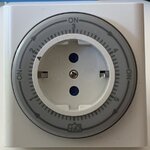Those Satiator chargers are the nazz and I'm sure you'll enjoy using yours.
Let me suggest that you try charging the bike at 85%, 90%, and 95% also, just to see what the performance of the bike is like. You don't get the same level of performance at 80% that you do at a higher level. The bike is zippier and a lot more fun. You might decide that this is worth it. The battery won't get the same longevity, but you might decide it's worth it to get the most out of your bike. If you find a sweet spot at, say 90% (just an example, not an estimate of where that sweet spot really is), then the battery will still last longer compared to charging up to 100%.
Suppose you only got 4 years of service from the battery instead of 5, but your enjoyment of the bike was significantly higher. It's a question worth thinking about.
I have a 48 volt battery. At 80% the bike's response is already noticeably lower. Not bad, far from awful, but definitely not what it is at 95%, which is what my stock charger provides. I'd really not want to miss that higher 15%. With a 52 V battery, those figures would definitely change and I'd have to experiment to find the sweet spot.
